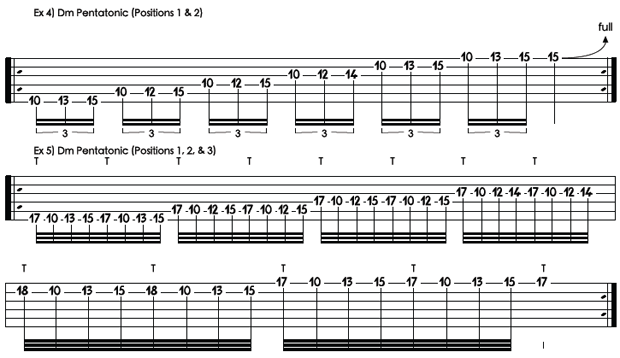Combining Pentatonics with Tapping
Take the most common pentatonic positions and string them together to create ripping-fast riffs and runs.

In this lesson, I’ll be taking the most common pentatonic positions and showing you how to string them together to create ripping-fast riffs and runs.
It’s a great way to break out of typical pentatonic licks and is easy to visualize all over the neck.
First, let’s take a look at EXAMPLE 1. This is a basic D minor pentatonic scale on the 10th fret. This whole lesson is based on expanding this scale—so make sure you have it down before you move on to the following examples.
EXAMPLE 2 also uses the Dm pentatonic scale, this time starting on the next degree of the scale (F). This position is crucial for expanding on your basic pentatonic scale (EXAMPLE 1). It also works great for transitioning up and down the neck when you’re shredding fast leads.
Moving on to EXAMPLE 3, we’re going to move our Dm pentatonic scale up one more position, this time starting on the note G. This position works great for many musical contexts and works particularly well for playing slow and melodically.

EXAMPLE 4 is where things are going to get a little more interesting. This example combines EXAMPLE 1 and EXAMPLE 2 into one position. Notice that there are now three notes per string. For this, you can use any left hand fingering you’d like; however, I use my pinky on the highest note of every string. For me, it makes it easier to play fast and keeps everything consistent.
Now, for EXAMPLE 5, we’re going to combine EXAMPLES 1, 2 and 3 into one large position. We’re going to accomplish this is by tapping the highest note on every string. When I am tapping and changing strings, I like to transition between strings by playing the tapped note first. This helps me groove harder and generally sounds more interesting than going directly up and down a scale.
All the latest guitar news, interviews, lessons, reviews, deals and more, direct to your inbox!
TIP: If you’re having a hard time visualizing EXAMPLE 5 on the neck, notice that you tap the 17th fret on every string except the B string, where you tap the 18th fret. You can get away with tapping the 17th fret on every string, however for the sake of keeping everything completely pentatonic, try making the change on the 18th fret of the B string.
Once you have EXAMPLE 5 up to speed, try to move it other keys and positions. The final example is a great gateway into modern shred guitar. I hope you enjoy playing it as much as I do. Cheers.

Sammy Boller is a guitarist from Detroit, MI. His debut instrumental record will be released later this year. To contact Sammy or ask him a question, email him at sammyboller@gmail.com or follow him on Instagram @sammyboller
